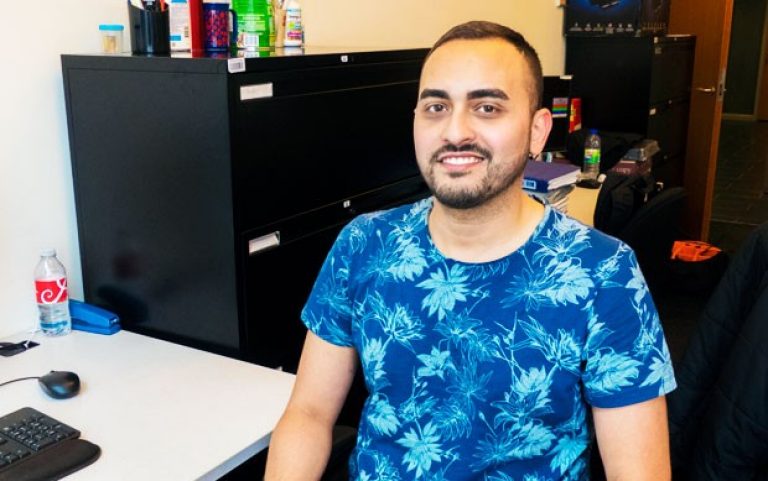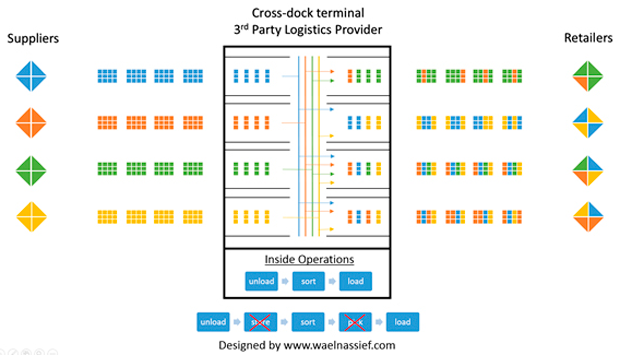PhD student is streamlining your Amazon delivery

You’re strolling through Canadian Tire, gazing up at aisle upon aisle of toasters, electric drills, air fresheners and flashlights. Ever stop to wonder how they all got there?
It’s actually a much more complicated process than you might imagine. In fact, it requires its very own area of interdisciplinary research, referred to as freight transport logistics, which does work at the intersection of mathematics, engineering and management. The field is closely related to an academic discipline known as decision science or operations research.
This is the field in which Wael Nassief (PhD 17), a postdoctoral fellow in the Department of Computer Science and Software Engineering, does his research. He applies advanced mathematical models in order to make better decisions in large-scale operations.
For Nassief, that means working very hard to optimize the operation of cross-docks, which are hubs within a supply chain where items are unloaded from incoming trucks and loaded directly onto outbound trucks headed to their next destination.
The purpose of cross-docks is to eliminate the need to store freight in warehouses. Needless to say, “on-the-fly” sorting can create a chaotic environment that benefits from the application of mathematical modelling.
Most of the items at Walmart arrived via a cross-dock

How does this specific image relate to your research at Concordia?
Wael Nassief: This image shows a typical cross-dock facility. Products are unloaded from incoming trucks, consolidated according to their destinations, and then loaded onto outbound trucks headed to their next destination, all of which is done within 24 hours. Cross-docks forego long-term storage in favour of rapidly moving goods on to their final destination.
My work strives to figure out how to assign and sequence both incoming and outgoing trucks to specific doors at the cross-dock in order to optimize a given performance criteria. These include minimum delivery time, minimum return time for emptied trucks or improving the speed and performance inside the facility. Most of the items you see for sale at Walmart have arrived via a cross-dock.
What is the hoped-for result of your project? And what impact could you see it having on people's lives?
WN: The nice thing about decision science is the ability to take information, mathematical models or algorithms we learn from one application and apply them to another.
For example, scheduling trucks over a limited number of doors at one side of a cross-dock resembles scheduling incoming flights over inbound gates at an airport or scheduling products over parallel machines in a factory.
Optimizing operations at cross-docks also allows for the fast movement of products in the supply chain. The end user may receive the product at an earlier time.
Have you ever wondered how Amazon manages to provide you with several delivery time options? Or how we have to drop off our packages at the post office before a certain time in order for them to be delivered the next day? Cross-dock implementation improves such processes.
What are some of the major challenges you face in your research? What are some of the key areas where your work could be applied?
WN: The challenge is that every day, things in the freight industry just grow bigger and bigger. Developing new models and algorithms that are adequate for increased scale is a constant task.
Operations research is an interdisciplinary field that can be applied in areas such as telecommunication, transportation, aviation, health care and postal services.
What person, experience or moment in time first inspired you to study this subject and get involved in the field?
WN: I have always liked mathematics and programming. For a long time, I couldn’t find a way to put these together for work that was practically applicable and enjoyable. When I started my PhD, I actually wasn’t quite sure what I was going to do.
After a few months of working with my supervisors, who taught me a lot, I started to understand and enjoy decision science. I began seeing the whole process, from mathematical modelling, to decomposing large-scale problems, to coding or programming, to executing and publishing.
I was utilizing math and programming at every step, in addition to operations research tools. I can now see myself working in this area for a long time.
How can interested STEM students get involved in this line of research? What advice would you give them?
WN: You need to acquire and enjoy three skills in this field: mathematics, programming and mathematical modelling or formulation. In other words, you need to develop the ability to represent a real-life problem as a system of equations interacting with one another to achieve a certain objective.
If you enjoy linear algebra, this is an interesting field where it can be applied. If you love creating decision-making tools for yourself and others, then learning operations research will definitely formalize this for you. You will apply these tools on a larger scale, where the human brain alone cannot solve the problem.
What do you like best about being Concordia?
WN: Diversity. The fact that I can interact with my lab mates and throughout the university campus with people from different backgrounds and cultures.
Are there any partners, agencies. or other funding or support attached to your research?
WN: When I did my PhD, which I recently finished, I was sponsored by the Saudi Arabian Cultural Bureau in Ottawa. Now I am a postdoctoral fellow at Concordia with a Mitacs Elevate award.
Find out more about Concordia’s Department of Computer Science and Software Engineering.


